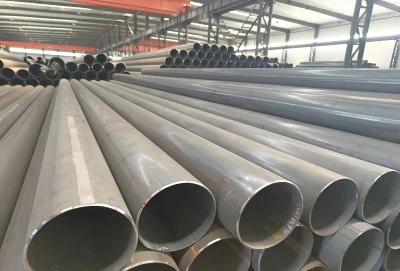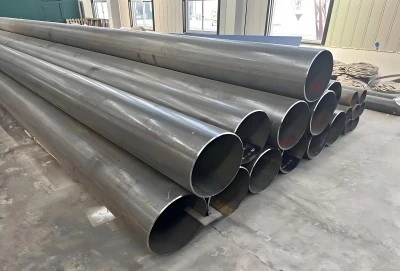In the realm of structural engineering and construction, the choice of materials plays a crucial role in determining the success and longevity of a project. Among the various options available, straight seam welded pipes have emerged as a preferred choice for many structural applications. This comprehensive guide explores the reasons behind this preference, the load-bearing capabilities of these pipes, and their significant contributions to large-scale construction projects.
|
|
|
Why is Straight Seam Welded Pipe Preferred in Structural Applications?
Straight seam welded pipes have gained popularity in structural applications due to their unique combination of strength, versatility, and cost-effectiveness. These pipes are manufactured by rolling steel plates or coils into a cylindrical shape and welding them along a single longitudinal seam, resulting in a sturdy and reliable product.
One of the primary reasons for their preference is the superior strength-to-weight ratio. Straight seam pipes offer excellent structural integrity while maintaining a relatively lightweight profile. This characteristic makes them ideal for applications where both strength and weight considerations are crucial, such as in high-rise buildings, bridges, and offshore structures.
Moreover, the manufacturing process of straight seam welded pipes allows for precise control over dimensions and wall thickness. This level of accuracy is particularly beneficial in structural projects where exact specifications are essential for proper fit and function. The ability to produce pipes with consistent quality and dimensions contributes to easier installation and reduced on-site adjustments, ultimately saving time and resources during construction.
Another factor contributing to the popularity of straight seam pipes is their versatility. These pipes can be manufactured in a wide range of sizes, from small diameters suitable for residential construction to large diameters used in industrial and infrastructure projects. This flexibility allows engineers and architects to choose the most appropriate size for their specific structural requirements without compromising on strength or performance.
What are the Key Load-Bearing Capabilities of Straight Seam Welded Pipes?
The load-bearing capabilities of straight seam welded pipes are a critical factor in their widespread use in structural applications. These pipes exhibit excellent performance under various types of loads, including axial compression, bending, and torsional forces.
In terms of axial compression, straight seam pipes demonstrate high resistance to buckling and collapse. The continuous welded seam along the length of the pipe provides uniform strength distribution, enabling the pipe to withstand substantial compressive loads. This property makes them particularly suitable for use as columns and support structures in buildings and bridges.
When it comes to bending loads, straight seam pipes showcase impressive flexural strength. The circular cross-section of these pipes offers inherent resistance to bending moments, allowing them to maintain their shape and structural integrity under lateral forces. This characteristic is especially valuable in applications such as horizontal beams, truss members, and wind-resistant structures.
Torsional strength is another notable attribute of straight seam welded pipes. The seamless nature of their construction, barring the single longitudinal weld, provides excellent resistance to twisting forces. This property is particularly advantageous in applications where rotational loads are present, such as in crane booms, vehicle chassis, and certain types of machinery.
It's worth noting that the load-bearing capabilities of straight seam welded pipes can be further enhanced through various treatments and modifications. For instance, heat treatment processes can improve the mechanical properties of the pipe material, while the addition of internal or external stiffeners can increase its overall structural capacity.
How Do Welded Pipes Contribute to Large-Scale Construction Projects?
Welded pipes, particularly straight seam welded pipes, play a significant role in large-scale construction projects across various industries. Their contributions extend beyond mere structural support, encompassing aspects such as efficiency, cost-effectiveness, and design flexibility.
In high-rise building construction, these pipes are often used as structural columns and beams. Their high strength-to-weight ratio allows for the creation of taller structures without excessive weight, contributing to more efficient use of space and materials. Additionally, the ability to prefabricate welded pipe sections off-site can significantly reduce on-site construction time and labor costs.
Bridge construction is another area where straight seam welded pipes make a substantial impact. These pipes are frequently employed in the fabrication of bridge trusses, support columns, and even as the main structural elements in some designs. The ability to produce pipes with large diameters and thick walls makes them suitable for handling the immense loads associated with bridge structures while offering resistance to environmental factors such as wind and seismic activity.
In the realm of industrial construction, these pipes find applications in the creation of storage tanks, pressure vessels, and large-diameter pipelines. Their ability to withstand high internal pressures and external loads makes them ideal for these demanding applications. Moreover, the welding process used in their manufacture allows for the integration of various fittings and connections, facilitating complex industrial designs.
The use of straight seam welded pipes also contributes to the sustainability of construction projects. The efficient use of materials in their production, combined with their long service life and recyclability, aligns well with green building practices. Furthermore, the ability to create hollow structural sections with these pipes allows for the integration of building services within the structural elements, leading to more streamlined and space-efficient designs.
Contact Longma Group
Straight seam pipes have proven to be an invaluable asset in the world of structural engineering and construction. Their preferred status in structural applications stems from a combination of strength, versatility, and cost-effectiveness. The impressive load-bearing capabilities of these pipes, encompassing resistance to axial, bending, and torsional forces, make them suitable for a wide range of structural roles.
In large-scale construction projects, the contributions of pipes are manifold. From enabling the construction of taller buildings to facilitating efficient bridge designs and supporting complex industrial structures, these pipes have become an integral part of modern construction practices.
As the construction industry continues to evolve, with an increasing focus on efficiency, sustainability, and innovative design, their role is likely to grow even further. Their adaptability to various structural requirements and their alignment with sustainable building practices position them as a key material for the future of construction.
If you're considering using straight seam welded pipes for your next structural project, don't hesitate to reach out to the experts at Longma Group. With years of experience in manufacturing high-quality ERW and LSAW steel pipes, we can provide you with the perfect solution for your structural needs. Contact us today at info@longma-group.com to discuss how our products can contribute to the success of your construction project.














